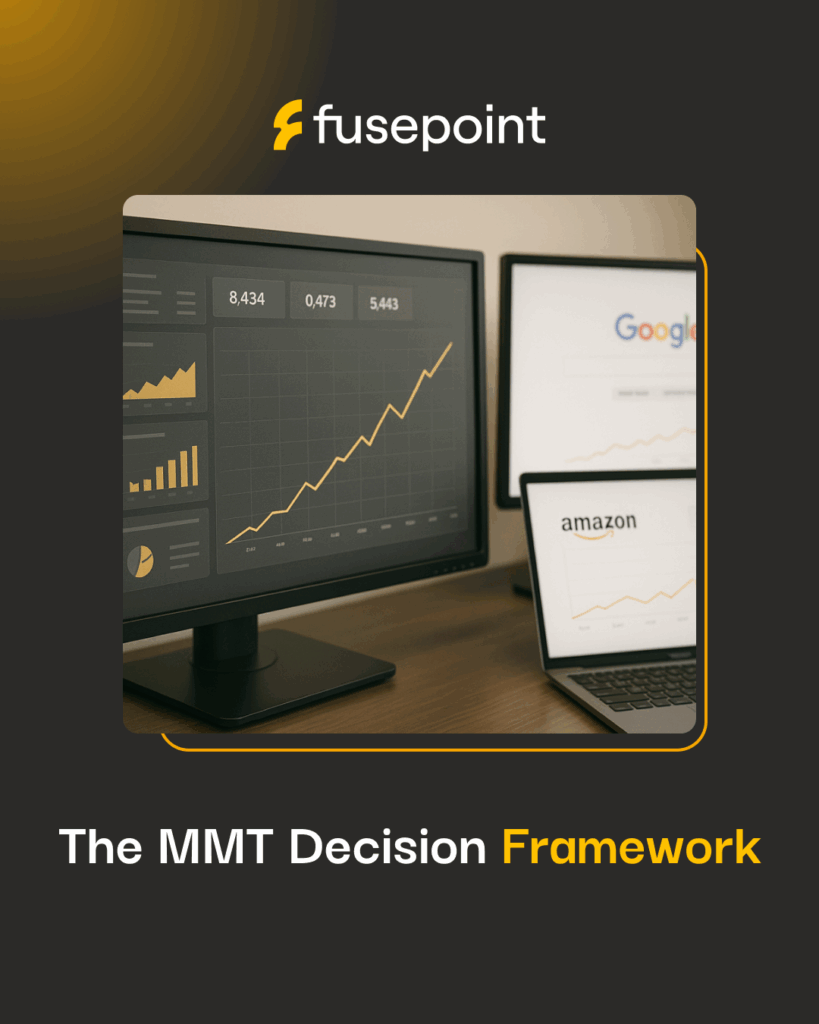What is Customer Profitability Analysis and Why it Matters

- 1. What is Customer Profitability Analysis (CPA)?
- 2. Key metrics in profitability analysis
- 3. How to conduct a customer profitability analysis
- 4. Use cases: How profitability analysis drives business decisions
- 5. Common mistakes in profitability analysis
- 6. Case study callout: How fusepoint improved ROI via profitability analysis
- 7. How fusepoint helps brands prioritize profitable growth
Every business decision comes down to one question: Is it profitable? Revenue might tell you that customers are coming in the door, but only profitability shows whether they are worth keeping once they’re inside.
Customer Profitability Analysis (CPA) makes that visible. It takes the noise of acquisition, retention, and service costs, and distills them into a clear picture of which customers generate real returns.
Without it, teams may celebrate activities that look impressive on paper but weaken the business underneath. With it, leaders can finally see where growth is compounding and where it’s slipping away.
Done right, CPA connects teams around the same question: Which customers are worth the investment, and which ones aren’t?
What is Customer Profitability Analysis (CPA)?
Customer profitability analysis measures the actual value of a customer after accounting for costs. Apart from generated revenue, it pulls in acquisition spend, servicing, retention, and margin to show the net value a customer contributes to the business.
For example, a customer who generates $1,000 in sales but requires discounts and high-touch support may return less profit than one who spends $500 with almost no servicing. Without CPA, both would look equally valuable.
-
Finance teams often approach CPA through activity-based costing, assigning expenses such as sales effort, onboarding, and support time to individual accounts.
-
Marketing and growth leaders can extend the analysis by layering in CAC, retention, and churn curves to project long-term customer profitability.
In practice, CPA becomes the link between marketing activity and financial outcomes by showing exactly where your acquisition dollars are going.
Key metrics in profitability analysis
Getting CPA right depends on three foundational metrics:
CAC vs. LTV
Customer Acquisition Cost (CAC) is the total spend you incur to acquire a customer (including marketing budgets, sales salaries, and onboarding) divided by the number of new customers.
LTV (or CLV), on the other hand, is the total net value a customer generates over time, once costs are accounted for. The CLV formula is often modeled as:
LTV= Contribution Margin / (1 – Retention Rate)
Note: This equation must be adjusted for discounting and churn curves in more advanced models.
The ratio between LTV and CAC is a classic unit economics litmus test. A 3:1 ratio is often cited as a healthy benchmark in SaaS and e-commerce circles: That is, for every $1 spent in acquisition, you get $3 back over time.
A simple rule of thumb here is that if CAC exceeds LTV, you’re not getting value. On the other end, if LTV is orders of magnitude above CAC, you may be underinvesting in growth.
Gross margin (by segment)
Revenue minus direct cost is only half the picture, since customers differ in how much it costs to serve them. They may require:
-
Premium support
-
Frequent returns
-
Logistics complexity
-
Deep discounts
Hidden value can be revealed by segmenting gross margin by cohort, acquisition channel, product line, or customer tier. A cohort that appears “good” revenue-wise might deliver poor margins once service and support costs are factored in.
For example, customers brought in through discounts might inflate top-line revenue but compress your margins. Meanwhile, customers acquired via referral may spend less initially, but with lower support costs, their net margin may be stronger.
Put simply, high spenders aren’t always high profit drivers, and low spenders aren’t always low value.
Retention and churn impact
Retention and churn are critical because they determine how long that margin compounds. Even a high-margin customer loses value quickly if they churn early.
Churn rate = (Customers lost in period) / (Customers at start of period)
Retention rate = 1 – churn rate
For example, if churn is 5% per month, retention is approximately 95%, meaning that each month, you lose 5% of your customer base. This can add up over the course of 12 months.
A Harvard Business School study introduced a “profit-based loss function” for retention. It found that predicting who will churn is not enough: You should also predict which churning customers cause the biggest profit loss and weight retention efforts accordingly.
In other words, paying $10 to retain a low-margin customer may be less valuable than investing $10 to retain a high-margin one.
How to conduct a customer profitability analysis
A reliable customer profitability report requires disciplined data collection, structured segmentation, and the willingness to challenge assumptions.
Step 1: Gather accurate customer data
The foundation of CPA is clean, reliable data. At a minimum, you need:
-
Revenue per customer (by product, channel, or cohort)
-
Acquisition costs, including marketing, sales, and onboarding
-
Direct service and support costs
-
Retention and churn metrics
-
Gross margin by product line
The goal is to gain a comprehensive view of customer economics, rather than a siloed snapshot.
Step 2: Segment customers by profitability
Segmenting customers enables you to see patterns that are obscured by blended averages. Typical cuts include:
-
Acquisition channel (organic, referral, paid ads)
-
Customer tier (SMB vs enterprise)
-
Product line or subscription plan
-
Geography or market
For example, a luxury apparel brand may see that first-time customers acquired during seasonal sales rarely return. At the same time, those who purchase at full price through retail stores become repeat buyers with higher lifetime profitability. Segmentation makes this difference clear.
Step 3: Compare costs vs. margin contribution
For each segment, map acquisition and service costs against margin contribution. This is where profitability becomes visible.
-
A segment that delivers strong revenue but requires heavy discounting may net out negative.
-
Another with lower topline but minimal service costs may deliver a stronger ROI.
This is where activity-based costing (ABC) is particularly helpful. Assigning real costs (such as sales time, onboarding hours, and support tickets) to customers prevents low-value cohorts from being subsidized by higher-value ones.
Step 4: Apply insights to decision-making
CPA is only useful if it shapes strategy. Once segments are ranked by profitability:
-
Marketing can reallocate spend toward high-value cohorts.
-
Finance can forecast cash flow more accurately by factoring in payback and retention.
-
Leadership can align growth goals with profitability, rather than focusing on volume.
Use cases: How profitability analysis drives business decisions
Insights from profitability analysis are only useful if they inform pricing, budgeting, and growth decisions.
Pricing strategy
A segment may appear healthy in terms of revenue before margin and cost-to-serve are taken into account.
That insight forces teams to be more disciplined about pricing, showing where:
-
Discounts are eroding profits
-
Customers can sustain higher rates
-
Tiered models are justified
Instead of guessing at willingness to pay, CPA provides the evidence to set prices that protect long-term margins.
Resource allocation
Every dollar invested in growth has an opportunity cost. CPA clarifies where those dollars compound and where they don’t.
Instead of spreading acquisition and retention spend evenly, leaders can redirect budget toward cohorts with strong payback and predictable expansion potential.
M&A diligence and valuation
In acquisitions, revenue can mislead. Two companies might show the same top-line growth, but one builds it on profitable, long-term customers while the other relies on discounts and accounts that churn quickly.
For investors, making CPA part of their due diligence helps to distinguish truly good investments.
Common mistakes in profitability analysis
Profitability analysis often fails not in the math, but in its application.
Managing to averages
With blended profitability, high-value customers end up subsidizing low-value ones. Only segment-level CPA surfaces the truth behind these inefficiencies.
Ignoring indirect costs
Discounting and support costs are obvious. Less visible are indirect costs, like product customization, success management, and infrastructure overhead. Leave these out, and complex accounts look much more profitable than they are.
Chasing revenue contribution alone
Large contracts or high order volumes do not guarantee profit, especially if retention is weak or service costs are high. CPA helps teams get to this truth.
Treating CPA as a snapshot
Shifts in pricing, competition, or customer behavior can rapidly alter the economics of a segment. Thus, CPA needs to be built into ongoing measurement systems, rather than being treated as a quarterly audit.
Case study callout: How fusepoint improved ROI via profitability analysis
fusepoint’s recent work supporting digital marketing for luxury brands illustrates how CPA principles translate into business impact. Too much of their spending was tied up in one channel, testing was limited, and profitability wasn’t part of the decision-making process.
-
fusepoint started with a comprehensive audit of the brand’s marketing accounts, identifying wasted spend.
-
Next came a “bake-off” between measurement techniques to ensure only the most accurate models were used to guide strategy.
-
From there, fusepoint applied advanced Marketing Mix Modeling (MMM) and Media Measurement Techniques (MMT) to diagnose performance at a granular level. The analysis revealed that the brand was overly reliant on Meta and was missing opportunities in other channels.
With profitability as the lens, the brand shifted spend into higher-return areas. The impact was clear: ROI increased from 1.19x to 2.60x, alongside a 2.18x increase in incremental return, which added millions in profit. Just as importantly, the business started balancing growth with profitability, laying a foundation for scalable, profitable growth..
How fusepoint helps brands prioritize profitable growth
If your growth strategy still leans on revenue alone, you’re only seeing half the picture. A customer profitability report is what brings the other half into focus.
As customer profitability consultants, fusepoint helps brands make profitability the filter for every decision.
We combine CPA with marketing mix modeling and incrementality testing to reveal the true economics of growth. That means identifying which customers generate durable value, which channels compound returns, and which investments are detrimental to your margin.
The outcome is a measurement system leadership can trust, where every dollar allocated to growth is tested, traceable, and durable. That’s the standard that fusepoint can help your brand achieve.
Sources
Theseus. Designing a Human-Centric Sales Framework for Early-Stage SaaS Startups.
https://www.theseus.fi/handle/10024/876744
Yale School of Management. On the Nature of Customer Attrition and Revenue Analysis.
Harvard Business School. Managing Churn to Maximize Profits.
https://www.hbs.edu/ris/Publication%20Files/14-020_2d6c9da0-94d3-4dd5-9952-d81feb432f61.pdf
Geneva Business School. High volume low margin or high margin low volume?
https://gbsge.com/newsroom/high-volume-low-margin-or-high-margin-low-volume/
Harvard Business School. Time-Driven Activity-Based Costing.
https://www.hbs.edu/ris/Publication%20Files/04-045_d62528d4-7931-4ea1-a205-d9683c639d6e.pdf
McKinsey & Company. The new growth game: Beating the market with digital and analytics.
PubMed Central. Customer Profitability Analysis in decision-making–The roles of customer characteristics, cost structures, and strategizing. https://pmc.ncbi.nlm.nih.gov/articles/PMC11111084/
Our Editorial Standards
Reviewed for Accuracy
Every piece is fact-checked for precision.
Up-to-Date Research
We reflect the latest trends and insights.
Credible References
Backed by trusted industry sources.
Actionable & Insight-Driven
Strategic takeaways for real results.










